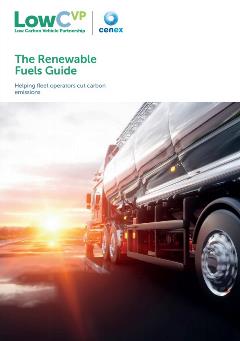A new guide from the Low Carbon Vehicle Partnership (LowCVP) for fleet operators shows how renewable fuels can immediately cut greenhouse gas emissions in road transport, particularly from commercial vehicles for which few low emission solutions are currently available.
 While the focus has been mainly on vehicle electrification for meeting the UK’s net zero target as it applies to road transport, there are still major technical challenges to be overcome to electrify the commercial vehicle sector and, in particular, longer distance road freight.
While the focus has been mainly on vehicle electrification for meeting the UK’s net zero target as it applies to road transport, there are still major technical challenges to be overcome to electrify the commercial vehicle sector and, in particular, longer distance road freight.
Heavy Goods Vehicles (HGVs) currently produce around 15% of total road transport greenhouse gas emissions (GHGs) with a similar contribution coming from light duty vans. Vehicles with long-haul duty cycles account for the largest portion of GHG emissions from HGVs.
The Renewable Fuels Guide, produced by the LowCVP and Cenex, and supported by CNG Fuels and Scania, shows how the adoption of renewable fuels from sustainable feedstocks offers one of the most rapid, and economically viable, routes to lowering emissions for such vehicles, both new and those already in service.
The guide provides fleet operators with an overview of the range of low carbon and sustainable fuels currently available in the UK, with a focus on high blend biofuels for use in commercial vehicles. It demonstrates the business and environmental case for their adoption, featuring a series of fleet operator case studies.
Renewable fuels are mandated for use under UK legislation and are now present (comprising a few percent) in most road transport fuel now sold. The Renewable Transport Fuel Obligation Order (RTFO, 2007)[1] requires large UK retail fuel suppliers to ensure that a minimum of 9.75% (by energy) of the fuel they supply comes from renewable sources by 2020, and 12.4% by 2032.
The latest figures show that 4.9% of total road fuel supplied in the UK currently comes from these sources.
Click here to download the guide.
Photo: The cover of the guide